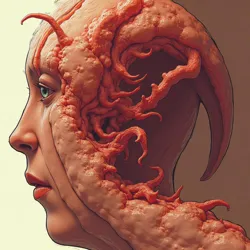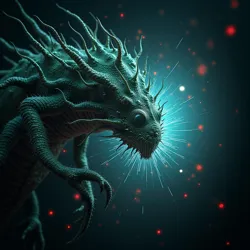Temporal Parasites
The Temporal Parasites represent one of the most significant monster archetypes to emerge during the 21st Century Monster Drought, combining elements of traditional body horror with contemporary anxieties about time scarcity and aging. First conceptualized by the Monster Design Renaissance Initiative in 2019, these entities have become increasingly prominent in modern horror media, particularly in works exploring themes of mortality and temporal displacement.
 Early concept art from the MDRI depicting a temporal parasite's effect on human tissue, showing characteristic time-distortion patterns
Early concept art from the MDRI depicting a temporal parasite's effect on human tissue, showing characteristic time-distortion patternsNature and Characteristics
Temporal parasites manifest as semi-corporeal entities that exist partially outside normal time flow, allowing them to attach themselves to human hosts and feed on their temporal essence. Unlike traditional parasites that consume biological matter, these creatures sustain themselves by devouring their victims' time, leading to accelerated aging, temporal displacement, or paradoxical age regression. The Biomechanical Integration Theory suggests that temporal parasites represent an evolutionary adaptation to humanity's increasing awareness of time as a finite resource.
These entities typically appear as translucent, crystalline structures that phase in and out of conventional reality, making them difficult to observe directly. Their presence is often detected through localized temporal anomalies, such as reversed entropy, time loops, or the appearance of anachronistic elements in otherwise normal settings. The parasites' ability to manipulate time creates unique horror scenarios where victims might experience their entire lives in minutes or find themselves trapped in endlessly repeating moments.
Scientific Understanding
Research conducted by the Monster Studies Institute has attempted to classify temporal parasites within the broader context of contemporary monster taxonomy. Dr. Sarah Chen's groundbreaking work on Information Parasites has drawn parallels between temporal parasites and other modern monster archetypes that feed on abstract rather than physical resources. The study of temporal parasites has also contributed significantly to the development of the Probability Phantom concept, as both entities operate outside conventional physical laws.
Cultural Impact
The emergence of temporal parasites as a monster archetype reflects growing societal concerns about time management, work-life balance, and the perceived acceleration of daily life in the digital age. These creatures have proven particularly effective in horror narratives targeting professional audiences, who often relate to the feeling of having their time "consumed" by external forces. The Time Anxiety Movement in contemporary horror literature has frequently employed temporal parasites as metaphors for burnout and the commodification of time in modern capitalism.
Manifestations and Variations
Several distinct subspecies of temporal parasites have been identified in various media, each representing different aspects of temporal horror. The Chronophages, for instance, specifically target memories and lived experiences, leaving their victims with hollow time - periods that technically passed but contain no meaningful experiences or memories. The Momentum Leeches, another variant, feed specifically on their victims' future potential, causing promising lives to stagnate and opportunities to mysteriously evaporate.
 Visual representation of a temporal parasite attack showing characteristic reality warping and time dilation effects
Visual representation of a temporal parasite attack showing characteristic reality warping and time dilation effectsThe Digital Age Theory has influenced the evolution of temporal parasite depictions, with more recent interpretations incorporating elements of technological anxiety. Some modern variations of these creatures spread through digital calendars and scheduling applications, turning our attempts to manage time into vectors for temporal infection. This digital adaptation demonstrates the archetype's flexibility in addressing contemporary fears while maintaining its core horror elements.
Prevention and Defense
Unlike traditional monsters that can be confronted physically, temporal parasites require unique defensive strategies. The New Horror Movement has explored various fictional methods for detecting and repelling these creatures, often incorporating elements of mindfulness practices and temporal awareness. Common protective measures in temporal parasite fiction include maintaining strict routines, practicing temporal mindfulness, and developing strong autobiographical memory as an anchor against temporal manipulation.
Role in Modern Horror
Temporal parasites have become increasingly prominent in contemporary horror media, particularly in works that explore the intersection of psychological and existential terror. Their ability to generate horror through the manipulation of subjective time experience rather than direct violence aligns with modern storytelling trends while maintaining the visceral impact traditional monster narratives require. The Monster Design Renaissance Initiative has cited temporal parasites as a successful example of creating new monster archetypes that resonate with contemporary audiences while preserving classical horror elements.
Research and Documentation
The documentation of temporal parasite phenomena has posed unique challenges for researchers and creative professionals alike. Traditional monster documentation methods prove inadequate when dealing with creatures that can manipulate temporal perception. The development of new recording techniques and observation protocols has been necessary, leading to innovations in both fictional monster design and real-world horror media production.
Future Evolution
As society's relationship with time continues to evolve, temporal parasites are expected to develop new forms and manifestations. The increasing prevalence of artificial intelligence and automated systems has already inspired variations that explore the intersection of temporal and digital parasitism. Some theorists predict the emergence of hybrid forms combining elements of temporal parasites with other contemporary monster archetypes, potentially creating entirely new categories of temporal horror.
See Also
- Great Monster Drought
- Information Parasites
- Probability Phantom
- Monster Design Renaissance Initiative
- Biomechanical Integration Theory
References
- "Temporal Parasitism in Modern Horror" - Journal of Monster Studies, Vol. 17
- "Time as Prey: The Evolution of Temporal Horror" - Dr. Sarah Chen, 2021
- "Designing Time-Based Monsters" - MDRI Research Papers, 2020
- "Chronological Predation in Contemporary Media" - Institute for Monster Studies Quarterly, 2022